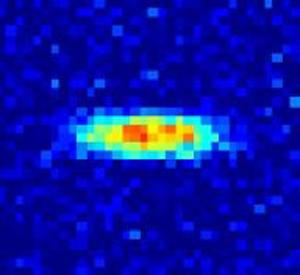The cold-molecule collaboration has developed a method for directly imaging ultracold ground-state KRb molecules. Their old method required the transfer of ultracold KRb molecules into a Feshbach state, which is sensitive to electric and magnetic fields. Thus researchers had to turn off the electric field and keep the magnetic field at a fixed value during the imaging process. However, the team recently began to probe the influence of changing electric and magnetic fields on the behavior of ultralow-temperature KRb molecules. Consequently, the researchers wanted to directly image ultralow-temperature KRb molecules in the ground state. However, the complex energy-level structure of molecules made the task of directly imaging molecules much more challenging than for atoms.
A collaboration team led by research associate Dajun Wang met this challenge. To do so, Wang had to find a molecular transition sensitive to a particular frequency of laser light. Then, he had to conduct experiments to determine how the molecules and photons interacted, including determining the laser intensity to use. The laser had to be intense enough so that most of the molecules in a ultracold molecular gas would absorb at least one photon. Then by counting the photons missing from the laser beam, the team could determine the number of molecules in the cloud.
But, the laser couldn’t shine too brightly or it would create noise due to the extra photons, and the molecular signal would get lost. It took Wang months to solve these two problems. He had help from graduate students Brian Neyenhuis and Marcio de Miranda, former graduate student Kang-Kuen Ni, former research associate Silke Ospelkaus, and Fellows Deborah Jin and Jun Ye.
Finally, the team found the right combination of frequency and intensity to get direct images of the ground-state molecules. To image the molecules, Wang shined a 658 nm laser at a cloud of KRb molecules in their ground state. Molecules absorbed photons from this pulse, creating a shadow image. Then to reduce background noise, Wang shined a second pulse of the same wavelength on the same apparatus without any molecules. By subtracting shadow image created by the first pulse from the light image, Wang got a good picture of the ground-state molecules.
Next, Wang and his team did experiments to see what they could learn with the new technique. They found that if they aimed their laser pulses at an ultracold molecule cloud and turned off the trap (which lets the cloud expand), they could determine the momentum and position distributions of molecules in the original cloud. One of a series of pictures taken during the cloud’s expansion (after 2 ms) is shown above.
The experiments included the imaging of molecules under an arbitrary combination of electric and magnetic fields. Thus, the team achieved what it set out to do. From now on, direct imaging should be a powerful tool for studying molecular quantum gases. - Julie Phillips



 The Physics Frontiers Centers (PFC) program supports university-based centers and institutes where the collective efforts of a larger group of individuals can enable transformational advances in the most promising research areas. The program is designed to foster major breakthroughs at the intellectual frontiers of physics by providing needed resources such as combinations of talents, skills, disciplines, and/or specialized infrastructure, not usually available to individual investigators or small groups, in an environment in which the collective efforts of the larger group can be shown to be seminal to promoting significant progress in the science and the education of students. PFCs also include creative, substantive activities aimed at enhancing education, broadening participation of traditionally underrepresented groups, and outreach to the scientific community and general public.
The Physics Frontiers Centers (PFC) program supports university-based centers and institutes where the collective efforts of a larger group of individuals can enable transformational advances in the most promising research areas. The program is designed to foster major breakthroughs at the intellectual frontiers of physics by providing needed resources such as combinations of talents, skills, disciplines, and/or specialized infrastructure, not usually available to individual investigators or small groups, in an environment in which the collective efforts of the larger group can be shown to be seminal to promoting significant progress in the science and the education of students. PFCs also include creative, substantive activities aimed at enhancing education, broadening participation of traditionally underrepresented groups, and outreach to the scientific community and general public.